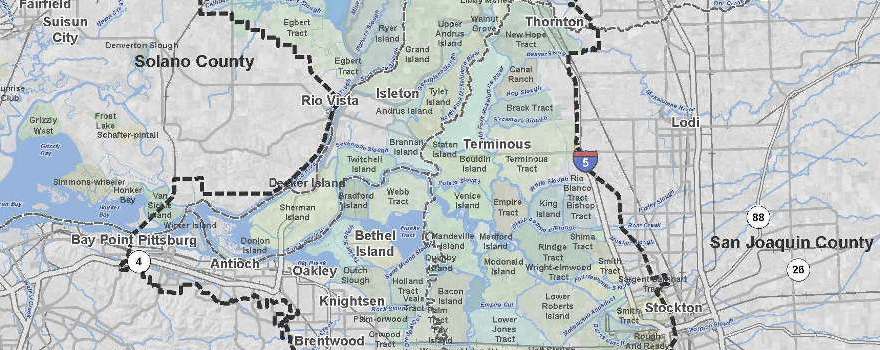
What is the effect of the amendment on the California Water Fix project? Randy Fiorini and Osha Meserve weigh in
This is the first of an occasional feature here on Maven’s Notebook where I will ask a really wonky question about California water and ask people to weigh in. This month’s question is regarding the recent Delta Plan amendment endorsed by the Delta Stewardship Council. Randy Fiorini, Chair of the Delta Stewardship Council, and Osha Meserve, an attorney representing Local Agencies of the North Delta and other Delta interests, weigh in. (Next up: unimpaired versus functional flows.)
At the June 22nd meeting of the Delta Stewardship Council, the council members voted to endorse an amendment to the Delta Plan to promote options for water conveyance, storage systems, and the operation of both. The amendment provides recommendations on the characteristics of conveyance, storage and operations that would contribute to a coordinated system with the improved flexibility necessary to achieve the state’s coequal goals of water supply reliability and ecosystem restoration. The amendment is proposed to be included as part of the overall Delta Plan that was originally adopted by the Council in May 2013.
BACKGROUND
The 2009 Delta Reform Act recognized that the state needed to change the way it uses the Delta, so the legislation did several things, among them: it established a policy of reducing reliance on the Delta through a statewide strategy of investing in improved regional supplies, conservation, and water use efficiency; and it also established the coequal goals of water supply reliability and ecosystem restoration as the overarching policy of the state. To manage the resources of the Delta, legislation created the seven-member Delta Stewardship Council and charged it with developing a comprehensive, long-term management plan for the Delta; it also directed the Council ‘to promote options for new and improved Delta conveyance, storage systems, and the operations of both in order to achieve the stated coequal goals.’ In May of 2013, the Council did adopt the first Delta Plan, which contained 14 regulatory policies and over 70 recommendations.
 At the time the Delta Reform Act was passed, the legislation provided that if the Delta tunnels project (then called the Bay Delta Conservation Plan or BDCP) would be if approved as both a Natural Community Conservation Planning (NCCP) program by the State and a Habitat Conservation Plan (HCP) by the federal government, it was to be automatically incorporated into the Council’s Delta Plan. The NCCP/HCP planning process is a much more intensive planning process that addresses ecosystem as well as infrastructure issues in exchange for 50-year permits to operate the project. So in anticipation of this, the Delta Plan as originally adopted in 2013 did not address conveyance but did provide that if the BDCP was not completed by January 2016, the Council would revisit the issue.
At the time the Delta Reform Act was passed, the legislation provided that if the Delta tunnels project (then called the Bay Delta Conservation Plan or BDCP) would be if approved as both a Natural Community Conservation Planning (NCCP) program by the State and a Habitat Conservation Plan (HCP) by the federal government, it was to be automatically incorporated into the Council’s Delta Plan. The NCCP/HCP planning process is a much more intensive planning process that addresses ecosystem as well as infrastructure issues in exchange for 50-year permits to operate the project. So in anticipation of this, the Delta Plan as originally adopted in 2013 did not address conveyance but did provide that if the BDCP was not completed by January 2016, the Council would revisit the issue.
Eventually, the uncertainty in the outcomes of the Bay Delta Conservation Plan caused the Brown Administration to change course and in April of 2015, it was announced that the project would return to the more traditional process and seek consultation and biological opinions for the new facilities. The new water infrastructure facilities would now be called “California Water Fix”; restoration activities, greatly downscaled to about one-third of the BDCP’s acreage, would be pursued separately under the “California Eco Restore” program.
In response, the Delta Stewardship Council began the process of developing the conveyance, storage, and operations amendment in August of 2015.
WHAT’S IN THE AMENDMENT?
The conveyance, storage, and operations amendment includes recommendations for infrastructure and operations that are intended, in combination with existing Delta Plan policies and recommendations, to further the coequal goals. The amendment calls for improved conveyance with multiple diversion locations in the Delta in order to provide flexibility in operations; new and expanded surface water reservoirs and groundwater storage to provide multiple benefits; and integrated operations of conveyance and storage systems in a manner that will realize their full and combined potential.
Amendment language also addresses community impacts by recommending project proponents consider and protect the unique character and historical importance of legacy communities, be consistent with the State’s policy regarding the human right to water, and incorporate good neighbor policies to avoid negative impacts on agricultural lands, residents, and businesses.
 Perhaps most controversially, the amendment language recommends that the Department of Water Resources and Reclamation pursue a ‘dual-conveyance’ option for the Delta. The term ‘dual conveyance’ refers to using a combination of the existing conveyance through Delta channels (or through conveyance) and then building a second method for water conveyance that would convey the water from a diversion point on the Sacramento River through a tunnel or a canal that goes under or around the Delta (or isolated conveyance). While the amendment language does recommend that an isolated conveyance be below ground, it should be noted that the amendment language does not prescribe the specific size, location, or configuration of such a conveyance or project.
Perhaps most controversially, the amendment language recommends that the Department of Water Resources and Reclamation pursue a ‘dual-conveyance’ option for the Delta. The term ‘dual conveyance’ refers to using a combination of the existing conveyance through Delta channels (or through conveyance) and then building a second method for water conveyance that would convey the water from a diversion point on the Sacramento River through a tunnel or a canal that goes under or around the Delta (or isolated conveyance). While the amendment language does recommend that an isolated conveyance be below ground, it should be noted that the amendment language does not prescribe the specific size, location, or configuration of such a conveyance or project.
Through the course of several meetings, many changes were made to the amendment language in response to comments made by both the Council members and the public. While Delta stakeholders saw many of their comments incorporated into the amendment language, especially with regard to construction impacts to the Delta residents and communities and in particular the legacy communities, they were not successful in persuading the Council away from promoting the dual conveyance option. In the end, the Council members voted to endorse the amendment 5-1, with Council member Skip Thomson from Solano County casting the lone dissenting vote.
NEXT STEPS FOR THE AMENDMENT
The endorsement of the conveyance, storage, and operations amendment now begins the required environmental review process before its final adoption, albeit at a programmatic level and not the more detailed project level report; the amendment will also be reviewed by the Delta Independent Science Board this summer.
The draft programmatic environmental review report is expected in fall of 2017. There will be additional opportunities for public comment at that time. Once the environmental review report is finalized, the Council will vote on acceptance of the environmental report and adoption of the amendment. It would then be incorporated into the relevant chapters of the Delta Plan, the majority being in Chapter 3; the narrative and recommendations would be added to the recommendations and policies already described in the chapter.
THE CALIFORNIA WATER FIX AND THE COUNCIL
The Delta Reform Act requires that any State or local agency that is proposing to carry out, approve or fund a plan, program, or project must certify that it is consistent with the Delta Plan’s regulatory policies.
The term “covered action” and is defined by the Delta Reform Act in Water Code section 85057.5(a)) as:
“a plan, program, or project as defined pursuant to Section 21065 of the Public Resources Code that meets all of the following conditions:
Will occur, in whole or in part, within the boundaries of the Delta or Suisun Marsh;
Will be carried out, approved, or funded by the state or a local public agency;
Is covered by one or more provisions of the Delta Plan;
Will have a significant impact on the achievement of one or both of the coequal goals or the implementation of government-sponsored flood control programs to reduce risks to people, property, and state interests in the Delta.
The State or local agency pursuing a project must self-certify that it is consistent with the Delta Plan. It is important to note that the Council itself does not have direct review and approval authority over covered actions to determine if they are consistent with the Delta Plan. However, any person, including Council members or its Executive Officer, may file an appeal with regard to a certification of consistency that has been submitted to the Council. The Council has the appellate authority to determine if a covered action is consistent with the Delta Plan if the certification of consistency is challenged.
The California Water Fix project meets the requirements set forth in the legislation as a covered action, so therefore the Department of Water Resources will have to certify that it is consistent with the regulatory policies of the Delta Plan. That self-certification can then be appealed to the Council, and due to the controversial nature of the California Water Fix project, an appeal is virtually certain.
CONVEYANCE, STORAGE, AND OPERATIONS AMENDMENT: REGULATIONS VERSUS RECOMMENDATIONS
The Delta Reform Act specifies that State and local agencies contemplating actions within the Delta must comply with the regulatory policies of the Delta Plan. It is important to note that the conveyance, storage, and operations amendment would add recommendations to the Delta Plan; they are not enforceable regulatory policies. Recommendations are intended to provide guidance to agencies implementing projects; it’s important to note that an agency is only required to certify consistency with the Delta Plan’s regulatory policies, but not the recommendations.
SO WHAT DOES IT ALL MEAN?
Given the Conveyance, Storage, and Operations amendment is only adding recommendations and not enforceable regulatory policies to the Delta Plan, what effect do you think passage of this amendment will have on the California Water Fix, and ultimately conveyance in the Delta?
I posed this question to Randy Fiorini, Chair of the Delta Stewardship Council; and Osha Meserve, counsel for Local Agencies of the North Delta, Friends of Stone Lakes National Wildlife Refuge and other Delta interests.
Here’s what they had to say.
Randy Fiorini answered …
 It is important to note that the Delta Plan already includes 14 policies that do have regulatory effect over projects that occur in whole or in part in the Delta, so-called “covered actions.” These regulations include requiring project proponents to prove they have reduced their reliance on the Delta; that the project meets the flow objectives of the State Water Resources Control Board’s Bay-Delta Water Quality Control Plan; protects opportunities to restore habitat; and is located to avoid or reduce conflicts with existing land uses, or those uses described in general plans. It also sets threshold requirements for project mitigation and requires the use of best available science.
It is important to note that the Delta Plan already includes 14 policies that do have regulatory effect over projects that occur in whole or in part in the Delta, so-called “covered actions.” These regulations include requiring project proponents to prove they have reduced their reliance on the Delta; that the project meets the flow objectives of the State Water Resources Control Board’s Bay-Delta Water Quality Control Plan; protects opportunities to restore habitat; and is located to avoid or reduce conflicts with existing land uses, or those uses described in general plans. It also sets threshold requirements for project mitigation and requires the use of best available science.
The proposed Delta Plan amendment for conveyance, storage and operations (CSO) describes the types and characteristics of infrastructure that could contribute to the coequal goals (though it does not identify specific projects), and identifies recommended criteria for project proponents to use in evaluating and developing new conveyance and storage projects. For example, the draft amendment encourages new or expanded storage projects that promote the interconnectedness of surface water and groundwater supplies and helps stabilize groundwater basins; it also recommends that new projects develop operating plans to meet specific and measurable targets and objectives, and incorporate adaptive management.
The proposed amendment results from over a hundred hours of public meetings and several public drafts, and comments from individuals and entities that represent interests across California. All this reminds us once again why the Delta and achieving the state’s coequal goals is considered one of the most challenging.
Osha Meserve answered …
 While some of the Delta communities’ and environmental organization concerns are mentioned in the proposed amendments, these weak provisions does nothing to ensure access to clean drinking water and irrigation water for the Delta’ cities and Prime Farmland, as well as fishing and water-contact recreation, or to protect local water uses generally. So while exporter water supplies might become more reliable with the Delta Tunnels, local water supplies will become too salty, too warm, and otherwise unreliable. The Council is doing nothing to prevent that outcome, in violation of the coequal goals. Water supply reliability includes the Delta and the surrounding cities.
While some of the Delta communities’ and environmental organization concerns are mentioned in the proposed amendments, these weak provisions does nothing to ensure access to clean drinking water and irrigation water for the Delta’ cities and Prime Farmland, as well as fishing and water-contact recreation, or to protect local water uses generally. So while exporter water supplies might become more reliable with the Delta Tunnels, local water supplies will become too salty, too warm, and otherwise unreliable. The Council is doing nothing to prevent that outcome, in violation of the coequal goals. Water supply reliability includes the Delta and the surrounding cities.
The Council’s weak, pro-Delta Tunnel amendments are a missed opportunity for the Council to positively influence conditions in the Delta. In particular, any conveyance amendments should require preparation of a water supply analysis to show the water is actually available for any new diversions and a cost-benefit analysis showing the project could pencil out for ratepayers. At the water rights proceedings at the SWRCB, we have seen evidence that the Delta Tunnels would divert Sacramento river water to which DWR and BOR are not entitled, making the petition a request for a new water right that should be subject to a water availability analysis. In addition, based on the information presented at Westlands Water District last week, would-be ratepayers in the San Joaquin Valley are balking at the costs when they see no new water would be provided by the project.
FOR MORE INFORMATION …
- Click here to read the conveyance, storage, and operations amendment as adopted by the Council.
- The Council also recently endorsed two other amendments, one addressing performance measures, and another regarding the Delta Levee Investment Strategy. Click here for more information on Delta Plan amendments.
- For more on the Delta Plan, click here.
 Sign up for daily email service and you’ll never miss a post!
Sign up for daily email service and you’ll never miss a post!
Sign up for daily emails and get all the Notebook’s aggregated and original water news content delivered to your email box by 9AM. Breaking news alerts, too. Sign me up!

